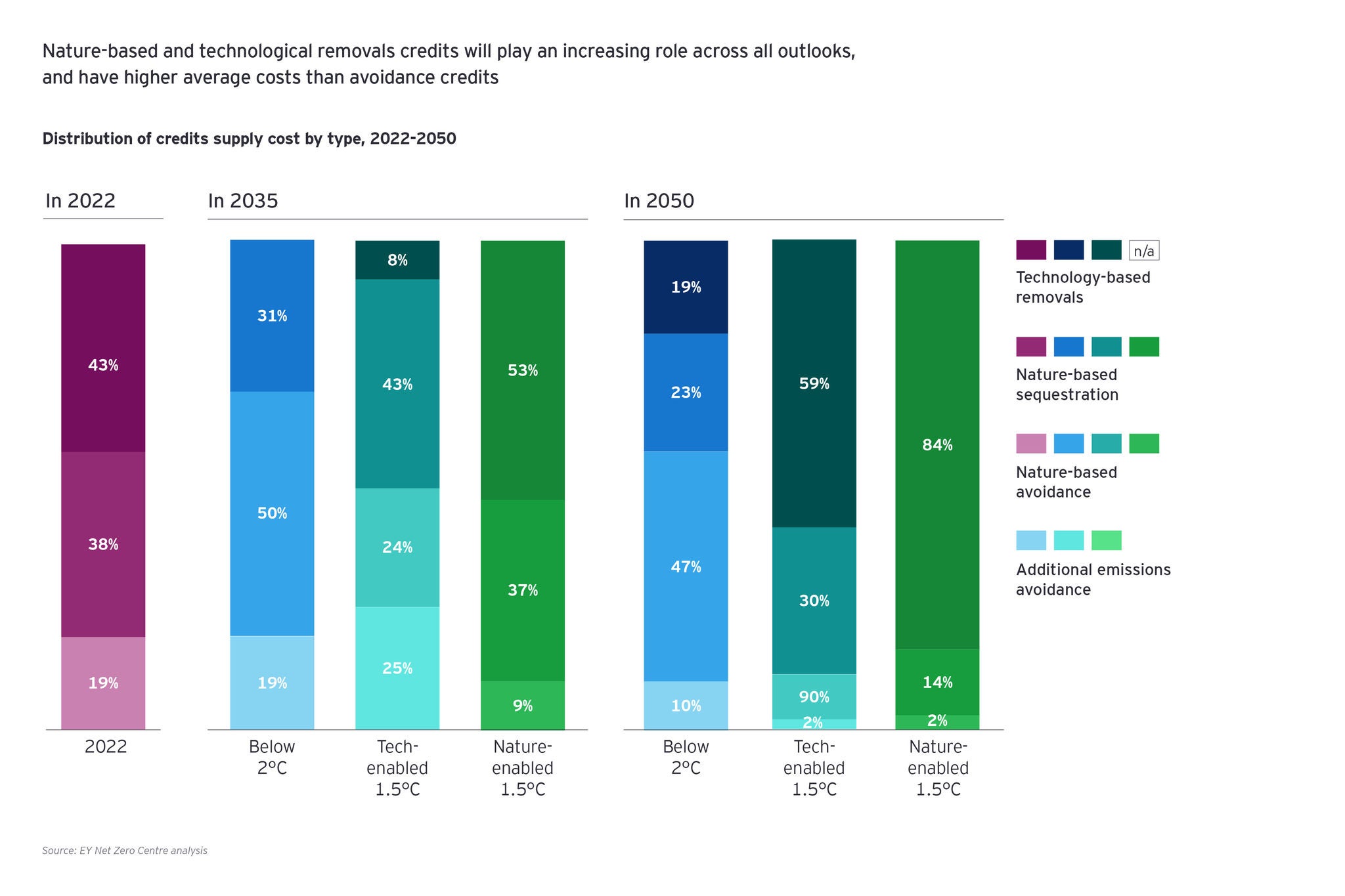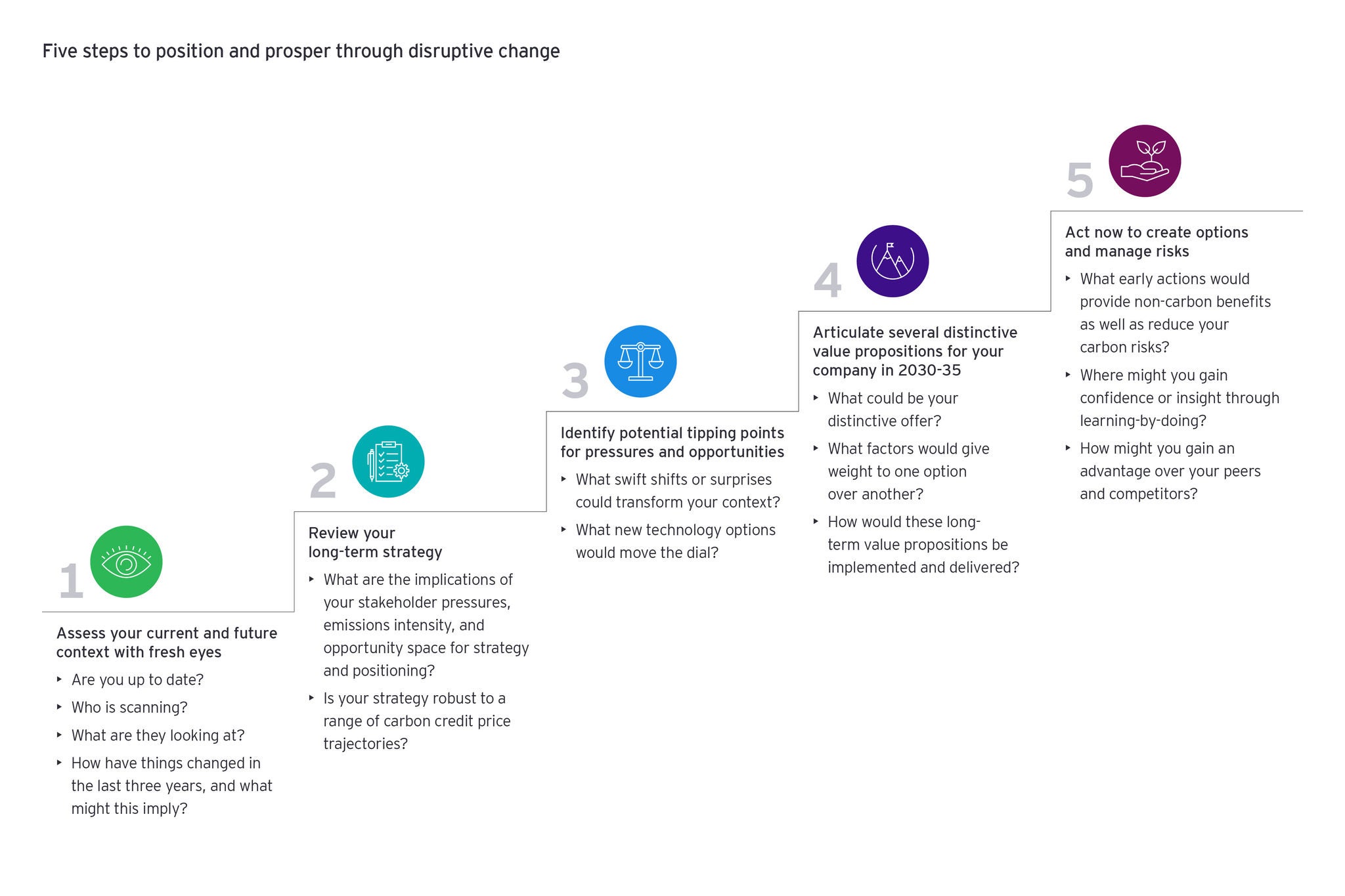EY refers to the global organisation, and may refer to one or more, of the member firms of Ernst & Young Global Limited, each of which is a separate legal entity. Ernst & Young Global Limited, a UK company limited by guarantee, does not provide services to clients.

Essential and still evolving: The global voluntary carbon market outlook 2024
In brief:
- Carbon credits remain at the heart of global efforts to limit dangerous climate change and achieve the emissions reductions required by the Paris Agreement.
- As businesses race to decarbonise, carbon credits offer a flexible and powerful mechanism to drive down emissions and achieve sustainability goals.
- However, carbon credits are becoming more expensive, with prices moving towards US$125 per tonne by 2035.
Businesses are under increasing pressure to act on climate change and to make deep cuts to their emissions. Trillions of dollars in climate finance need to be deployed annually to remove carbon from the atmosphere. To meet that need, voluntary carbon markets must grow.
With time, carbon could become a new commodity class. But first, businesses need standard frameworks, transparent data and trusted intermediaries to support industrial-scale removal.
The EY Net Zero Centre’s latest report, Essential and still evolving, outlines the crucial role that carbon credits will continue to play in decarbonisation strategies and offers an outlook for the voluntary carbon market. Building on the 2022 edition, this report updates insights into the dynamics of supply, demand and pricing in voluntary carbon markets.
EY analysis finds that scaling up credit volumes will quickly exhaust available low-cost supply, driving rapid increases in credit prices to 2035 across all scenarios.
Steve Hatfield-Dodds
Net Zero Centre Head of Research, Chief Climate Economics and Policy Officer (Oceania), EY-Parthenon Strategy
Carbon credits and carbon markets unpacked
Carbon credits are an essential part of the decarbonisation toolkit, smoothing the transition to net zero.
A range of terms are used when discussing carbon offsets. The EY Net Zero Centre defines:
- Carbon credit: A certified and transferrable instrument representing the avoidance or removal of one metric tonne of CO2 or equivalent greenhouse gases.
- Avoidance: Emissions that would have occurred under a defined ‘business-as-usual’ scenario, but that were prevented due to an offset project.
- Removal: CO2 or other gases that have been extracted from the atmosphere and safely stored.
Carbon credits are created by offset projects and can be retired to counterbalance the equivalent volume of residual emissions by the credit retiree.
Far from being a cover for inaction, carbon credits can enable faster, more impactful action. Evidence shows that businesses using carbon credits often set more ambitious emissions reduction targets than those that do not.
EY analysis finds that combining high-integrity credits with ambitious internal abatement lowers decarbonisation costs by 45%-65% in Paris-consistent scenarios, compared to relying solely on internal measures.
But increasing demand, a race to quality and rising unit supply costs will result in carbon credits becoming harder to find and costlier to purchase.
While prices will vary across market segments, the overall trend suggests that around 30%-50% of credits will likely exceed US$50 per tonne by 2035.

Voluntary carbon markets are still evolving
More than half of the world’s biggest companies have set net zero targets – and this is driving demand in voluntary carbon markets. But carbon credits have not yet earnt their social licence.
Despite growing demand, significant policy and philosophical divisions impede progress: debate between carbon removal and avoidance; preference for nature-based or technology-based projects; and the equitable distribution of benefits to local communities. Addressing integrity concerns will also require better and more rigorously enforced standards.
Several international initiatives promise to address shortcomings and strengthen confidence over time. These include:
- Voluntary Carbon Markets Integrity (VCMI): The VCMI, established in 2021, is setting principles and frameworks for high-quality carbon credits.
- Integrity Council for the Voluntary Carbon Market (ICVCM): The ICVCM, established in 2021, aims to enhance the overall efficiency and effectiveness of the voluntary carbon market.
- Global Carbon Market Utility (GCMU): Launched at COP27 in 2022, the GCMU aims to enhance the quality and transparency of carbon credits and to scale the global carbon market.
- International Sustainability Standards Board (ISSB): The ISSB’s first climate disclosure standards, published in 2023, encourage greater transparency and accountability, and enable a more informed comparison of the performance of companies.
These initiatives, together with regional initiatives like the European Union’s Carbon Border Adjustment Mechanism and several country-level carbon taxes, will strengthen confidence in the supply, trade and use of credits, and drive demand. The foundations are being laid, but it will take time for markets to flourish.
Over time, as national emissions budgets tighten, governments are likely to impose more stringent regulatory requirements on businesses, particularly in advanced countries. This will reshape voluntary credit markets.
Matthew Cowie
Climate Change and Sustainability Services Partner, EY New Zealand
Carbon credits: Tightening emissions budgets will drive carbon removals
In the long term, the widespread use of credits to meet compliance obligations can drive the world towards a well-regulated global market where carbon removals and recognised avoided carbon emissions are treated as a commodity class like oil, copper or wheat. This is particularly the case where carbon credits are used to offset activities where technology abatement opportunities are not mature or cost-effective. The challenge will be to commodify carbon while meeting the needs of businesses committed to supporting sustainability and inclusive growth.
As pressures from stakeholders increase and expectations escalate, the scale and scope of required emissions reductions will expand, while timeframes will contract. Voluntary carbon markets will evolve in response.
While the long-term trajectory points towards higher-quality, more expensive carbon credits, in the short-term, the needed “race to integrity” is off to a bumpy start. EY analysis finds markets will remain fragmented, at least in the medium term, as regulations and standards vary across regions. This will influence how businesses engage with the market and their willingness to pay higher prices for credits.
Credits based on carbon removal technologies are expected to take a more prominent role in supporting long-term moves towards net zero. Avoided emissions credits, which have played a significant role to date, are likely to decline in importance as emissions-intensive industries begin to retire carbon-heavy assets and processes.
However, achieving deep cuts in emissions will be expensive, particularly for businesses in industries where technological abatement options are not yet mature.
As carbon credit prices rise, it will be critical to prevent unfair competition from businesses that might face less stringent abatement requirements. Effective regulation will be essential to maintain a level playing field, and safeguard that carbon markets remain robust, transparent and capable of driving meaningful change.
A low-carbon call to action for businesses
How can business leaders respond? To stay competitive, businesses must proactively engage with carbon markets. With technology, climate science and stakeholder expectations evolving rapidly, businesses need clear decarbonisation strategies that leverage carbon credits to mitigate risks, capture opportunities and create value.
The decades ahead will be very different from those behind us. Essential and still evolving suggests business leaders consider five steps to position for disruptive change.

Summary
Carbon credits will become increasingly valuable, driving both emissions reductions and business innovation. As the costs of credits and abatement activities rise, business leaders who engage early and thoughtfully will be best positioned to shape the future with confidence.
Talk to the EY Net Zero Centre team to help your company cut through the complexity, manage the uncertainty and create clear pathways to net zero emissions.
Related Articles
How can carbon offsets create new value in a rapidly changing world?
Net zero emissions cannot be achieved without carbon credits, but the volume of credits required to meet climate targets could grow by 40-fold between now and 2035.
Australia’s carbon market is changing gears. Are you ready?
Your business doesn’t need to be captured by reforms to the Safeguard Mechanism (SGM) to need a carbon credits strategy.
How can the net zero transition create a nature-positive advantage?
Explore how Australia’s net zero goals could support a nature positive economy, biodiversity conservation, environmental protection and sustainability.







